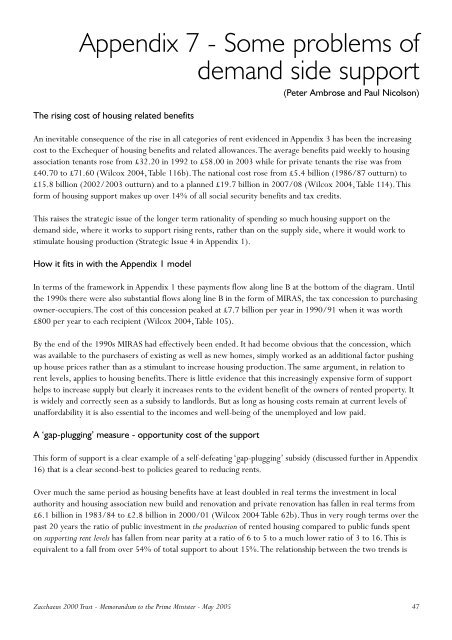Memorandum-to-the-Prime-Minister-on-Unaffordable-Housing
Memorandum-to-the-Prime-Minister-on-Unaffordable-Housing
Memorandum-to-the-Prime-Minister-on-Unaffordable-Housing
You also want an ePaper? Increase the reach of your titles
YUMPU automatically turns print PDFs into web optimized ePapers that Google loves.
Appendix 7 - Some problems of<br />
demand side support<br />
The rising cost of housing related benefits<br />
(Peter Ambrose and Paul Nicols<strong>on</strong>)<br />
An inevitable c<strong>on</strong>sequence of <str<strong>on</strong>g>the</str<strong>on</strong>g> rise in all categories of rent evidenced in Appendix 3 has been <str<strong>on</strong>g>the</str<strong>on</strong>g> increasing<br />
cost <str<strong>on</strong>g>to</str<strong>on</strong>g> <str<strong>on</strong>g>the</str<strong>on</strong>g> Exchequer of housing benefits and related allowances.The average benefits paid weekly <str<strong>on</strong>g>to</str<strong>on</strong>g> housing<br />
associati<strong>on</strong> tenants rose from £32.20 in 1992 <str<strong>on</strong>g>to</str<strong>on</strong>g> £58.00 in 2003 while for private tenants <str<strong>on</strong>g>the</str<strong>on</strong>g> rise was from<br />
£40.70 <str<strong>on</strong>g>to</str<strong>on</strong>g> £71.60 (Wilcox 2004,Table 116b).The nati<strong>on</strong>al cost rose from £5.4 billi<strong>on</strong> (1986/87 outturn) <str<strong>on</strong>g>to</str<strong>on</strong>g><br />
£15.8 billi<strong>on</strong> (2002/2003 outturn) and <str<strong>on</strong>g>to</str<strong>on</strong>g> a planned £19.7 billi<strong>on</strong> in 2007/08 (Wilcox 2004,Table 114).This<br />
form of housing support makes up over 14% of all social security benefits and tax credits.<br />
This raises <str<strong>on</strong>g>the</str<strong>on</strong>g> strategic issue of <str<strong>on</strong>g>the</str<strong>on</strong>g> l<strong>on</strong>ger term rati<strong>on</strong>ality of spending so much housing support <strong>on</strong> <str<strong>on</strong>g>the</str<strong>on</strong>g><br />
demand side, where it works <str<strong>on</strong>g>to</str<strong>on</strong>g> support rising rents, ra<str<strong>on</strong>g>the</str<strong>on</strong>g>r than <strong>on</strong> <str<strong>on</strong>g>the</str<strong>on</strong>g> supply side, where it would work <str<strong>on</strong>g>to</str<strong>on</strong>g><br />
stimulate housing producti<strong>on</strong> (Strategic Issue 4 in Appendix 1).<br />
How it fits in with <str<strong>on</strong>g>the</str<strong>on</strong>g> Appendix 1 model<br />
In terms of <str<strong>on</strong>g>the</str<strong>on</strong>g> framework in Appendix 1 <str<strong>on</strong>g>the</str<strong>on</strong>g>se payments flow al<strong>on</strong>g line B at <str<strong>on</strong>g>the</str<strong>on</strong>g> bot<str<strong>on</strong>g>to</str<strong>on</strong>g>m of <str<strong>on</strong>g>the</str<strong>on</strong>g> diagram. Until<br />
<str<strong>on</strong>g>the</str<strong>on</strong>g> 1990s <str<strong>on</strong>g>the</str<strong>on</strong>g>re were also substantial flows al<strong>on</strong>g line B in <str<strong>on</strong>g>the</str<strong>on</strong>g> form of MIRAS, <str<strong>on</strong>g>the</str<strong>on</strong>g> tax c<strong>on</strong>cessi<strong>on</strong> <str<strong>on</strong>g>to</str<strong>on</strong>g> purchasing<br />
owner-occupiers.The cost of this c<strong>on</strong>cessi<strong>on</strong> peaked at £7.7 billi<strong>on</strong> per year in 1990/91 when it was worth<br />
£800 per year <str<strong>on</strong>g>to</str<strong>on</strong>g> each recipient (Wilcox 2004,Table 105).<br />
By <str<strong>on</strong>g>the</str<strong>on</strong>g> end of <str<strong>on</strong>g>the</str<strong>on</strong>g> 1990s MIRAS had effectively been ended. It had become obvious that <str<strong>on</strong>g>the</str<strong>on</strong>g> c<strong>on</strong>cessi<strong>on</strong>, which<br />
was available <str<strong>on</strong>g>to</str<strong>on</strong>g> <str<strong>on</strong>g>the</str<strong>on</strong>g> purchasers of existing as well as new homes, simply worked as an additi<strong>on</strong>al fac<str<strong>on</strong>g>to</str<strong>on</strong>g>r pushing<br />
up house prices ra<str<strong>on</strong>g>the</str<strong>on</strong>g>r than as a stimulant <str<strong>on</strong>g>to</str<strong>on</strong>g> increase housing producti<strong>on</strong>.The same argument, in relati<strong>on</strong> <str<strong>on</strong>g>to</str<strong>on</strong>g><br />
rent levels, applies <str<strong>on</strong>g>to</str<strong>on</strong>g> housing benefits.There is little evidence that this increasingly expensive form of support<br />
helps <str<strong>on</strong>g>to</str<strong>on</strong>g> increase supply but clearly it increases rents <str<strong>on</strong>g>to</str<strong>on</strong>g> <str<strong>on</strong>g>the</str<strong>on</strong>g> evident benefit of <str<strong>on</strong>g>the</str<strong>on</strong>g> owners of rented property. It<br />
is widely and correctly seen as a subsidy <str<strong>on</strong>g>to</str<strong>on</strong>g> landlords. But as l<strong>on</strong>g as housing costs remain at current levels of<br />
unaffordability it is also essential <str<strong>on</strong>g>to</str<strong>on</strong>g> <str<strong>on</strong>g>the</str<strong>on</strong>g> incomes and well-being of <str<strong>on</strong>g>the</str<strong>on</strong>g> unemployed and low paid.<br />
A ‘gap-plugging’ measure - opportunity cost of <str<strong>on</strong>g>the</str<strong>on</strong>g> support<br />
This form of support is a clear example of a self-defeating ‘gap-plugging’ subsidy (discussed fur<str<strong>on</strong>g>the</str<strong>on</strong>g>r in Appendix<br />
16) that is a clear sec<strong>on</strong>d-best <str<strong>on</strong>g>to</str<strong>on</strong>g> policies geared <str<strong>on</strong>g>to</str<strong>on</strong>g> reducing rents.<br />
Over much <str<strong>on</strong>g>the</str<strong>on</strong>g> same period as housing benefits have at least doubled in real terms <str<strong>on</strong>g>the</str<strong>on</strong>g> investment in local<br />
authority and housing associati<strong>on</strong> new build and renovati<strong>on</strong> and private renovati<strong>on</strong> has fallen in real terms from<br />
£6.1 billi<strong>on</strong> in 1983/84 <str<strong>on</strong>g>to</str<strong>on</strong>g> £2.8 billi<strong>on</strong> in 2000/01 (Wilcox 2004 Table 62b).Thus in very rough terms over <str<strong>on</strong>g>the</str<strong>on</strong>g><br />
past 20 years <str<strong>on</strong>g>the</str<strong>on</strong>g> ratio of public investment in <str<strong>on</strong>g>the</str<strong>on</strong>g> producti<strong>on</strong> of rented housing compared <str<strong>on</strong>g>to</str<strong>on</strong>g> public funds spent<br />
<strong>on</strong> supporting rent levels has fallen from near parity at a ratio of 6 <str<strong>on</strong>g>to</str<strong>on</strong>g> 5 <str<strong>on</strong>g>to</str<strong>on</strong>g> a much lower ratio of 3 <str<strong>on</strong>g>to</str<strong>on</strong>g> 16.This is<br />
equivalent <str<strong>on</strong>g>to</str<strong>on</strong>g> a fall from over 54% of <str<strong>on</strong>g>to</str<strong>on</strong>g>tal support <str<strong>on</strong>g>to</str<strong>on</strong>g> about 15%.The relati<strong>on</strong>ship between <str<strong>on</strong>g>the</str<strong>on</strong>g> two trends is<br />
Zacchaeus 2000 Trust - <str<strong>on</strong>g>Memorandum</str<strong>on</strong>g> <str<strong>on</strong>g>to</str<strong>on</strong>g> <str<strong>on</strong>g>the</str<strong>on</strong>g> <str<strong>on</strong>g>Prime</str<strong>on</strong>g> <str<strong>on</strong>g>Minister</str<strong>on</strong>g> - May 2005 47




